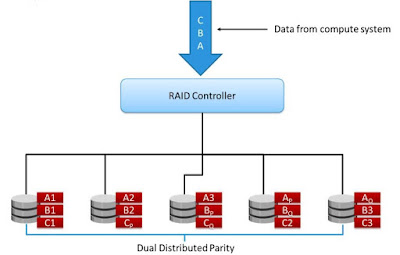RAID 6 works in the same way as RAID 5, except that RAID 6 includes a second parity element to enable survival if two disk failures occur in a RAID set. Therefore, a RAID 6 implementation requires at least four disks.
RAID 6 distributes the parity across all the disks. The write penalty in RAID 6 is more than that in RAID 5; therefore, RAID 5 writes perform better than RAID 6. The rebuild operation in RAID 6 may take longer than that in RAID 5 due to the presence of two parity sets. RAID 6 is based on polynomial erasure code technique which are generally used in future RAID techniques, data protection and in cloud based architectures.
RAID 6 distributes the parity across all the disks. The write penalty in RAID 6 is more than that in RAID 5; therefore, RAID 5 writes perform better than RAID 6. The rebuild operation in RAID 6 may take longer than that in RAID 5 due to the presence of two parity sets. RAID 6 is based on polynomial erasure code technique which are generally used in future RAID techniques, data protection and in cloud based architectures.
The parity in RAID 6 is distributed across all members of the RAID set. RAID 5 reserves the equivalent of one drives worth of blocks for parity whereas RAID 6 reserves two drives worth of block for two discrete sets of parity. This enables RAID 6 to suffer two failed drives without losing data. This makes RAID 6 an extremely safe RAID level.
Also Read: The next generation RAID techniques
Also Read: The next generation RAID techniques
The major downside of RAID 6 is performance, especially performance of small-block writes in an environment experiencing a high number of writes. Because RAID 6 doubles the amount of parity per RAID stripe, RAID 6 suffers more severely from the write penalty than RAID 5. The four I/Os per small-block write for a RAID 5 set becomes six I/Os per write for a RAID 6 set. Therefore, RAID 6 is not recommended for small-block-intensive I/O requirements, and in the vast majority of cases, it is not used for any heavy write-based workloads.
RAID 6 Use Cases
RAID 6 is a good all-round system that combines efficient storage with excellent security and decent performance. It is preferable over RAID 5 in file and application servers that use many large drives for data storage.
Also Read: Overview of RAID 10 and its use cases
Also Read: Overview of RAID 10 and its use cases
Advantages
- Like with RAID 5, read data transactions are very fast.
- If two drives fail, you still have access to all data, even while the failed drives are being replaced. So RAID 6 is more secure than RAID 5.
Disadvantages
- Write data transactions are slowed down due to the parity that has to be calculated.
- Drive failures have an effect on throughput, although this is still acceptable.
- This is complex technology. Rebuilding an array in which one drive failed can take a long time.
What Others are Reading Now...







0 Comment to "3.7 Overview of RAID 6 and its use cases"
Post a Comment